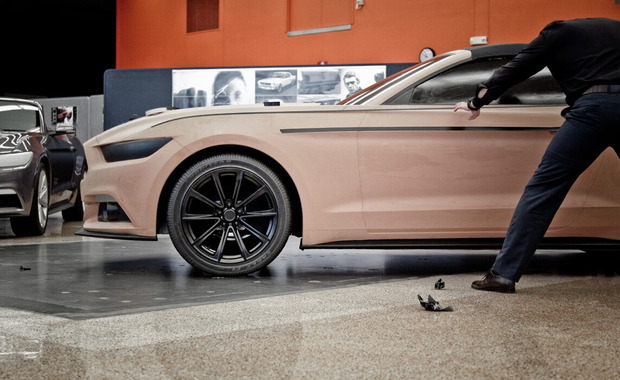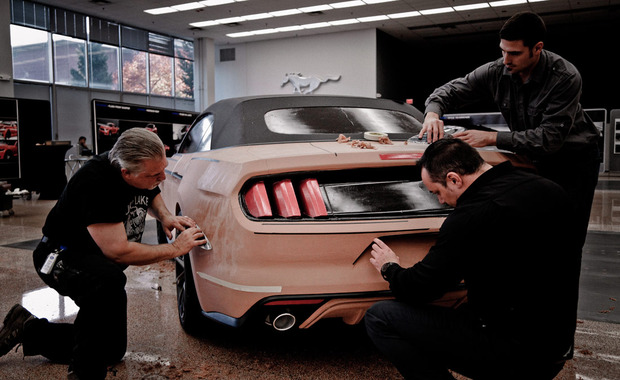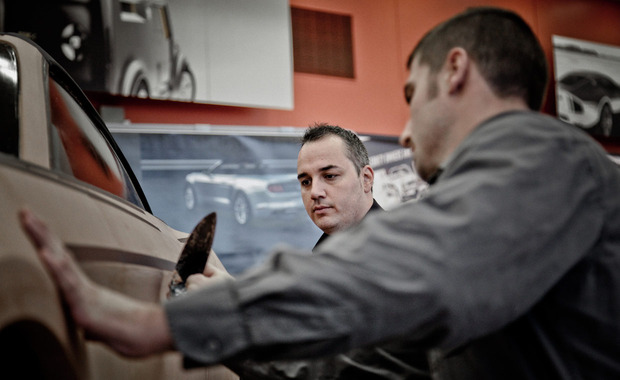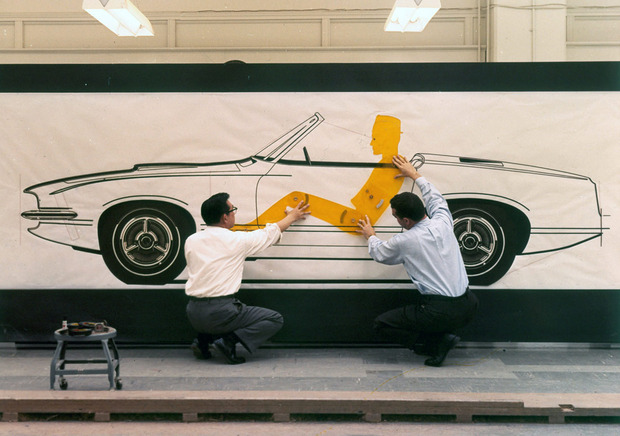The Language of Tape Design
A look at the age-old technique of using full scale clay models and tape in the automotive design process

When you think about automobile design, clay probably isn’t the first thing that comes to mind. From sketches on paper to refined 3D renderings made in CAD, the design remains almost solely in theory until the team moves to a clay model. Modelers and designers work hand-in-hand to provide precision adjustments to the design, using tape as a shared language. We spent some time in Ford‘s design studio, where one of their Master Modelers and a few designs walked us through the process.
While the auto industry thrives on innovation in technology and design tools, the men and women behind the designs know very well the best tool for each job isn’t always the most technologically advanced option. To outsiders, drawing with tape and hand-molding clay seems tedious at best—if not entirely outdated. Yet the professionals see it differently: “You can turn ideas around so fast. With all the technology we’ve got, rapid pro taping is still the fastest medium to get where we want to go,” explains Larry Pelowski, a Master Modeler, Exterior Design. “It’s pretty much universal between design and modeling. It’s just an invaluable tool.”

“It allows designers to tap into their gut feelings, which—in the end—are what give these great metal beasts their personality”
Tape as an integral part of the creative process is rarely seen outside of automobile design, and even at schools it’s not a major focus. It is, unusually, a skill picked up on the job, handed down from one generation of auto designers to the next. Tape plays many roles—from designating set portions of the design like headlights to suggesting possible body lines—it works dynamically with the clay model through the final design process. Even with the advent of 3D imaging software the ability to actually touch, feel and see the way the tape line lies on the clay body provides much needed feedback that computers cannot provide. It allows designers to tap into their gut feelings, which—in the end—are what give these great metal beasts their personality. Plus, the issue is often as simple as understanding that what looks great in two dimensions doesn’t always in three.

“It’s not only a tool for describing the vehicle, a tool for describing the surface, it’s a tool for describing your intentions,” elaborates Garen Nicoghosian, an Exterior Design Manager. “You can use it to write with, you can use it to draw with. It’s like a calligraphy pen; you have so many options [and] you can portray so many feelings with tape.” Pulling a perfect line in tape is a skill that designers become proud of and admired for. These feelings extend to where body lines should be raised, lowered or erased entirely. Without fail, the design dialogue is directed through the two dimensional tape. Perhaps most importantly it allows you to see perspective and how lines look around corners.

“You can be from any part of the world and if you’re a part of our profession, you can speak through tape”
While clay models are heavily used in automotive design, the technique has also been used with large mylar illustrations which were hung on the wall, where designers would apply tape in much the same way. Through time and across continents, the design refinement technique has proven invaluable amongst industry insiders. “The value of it is it’s literally a language breaker,” continues Nicoghosian. “It’s a barrier breaker for us because you can be from any part of the world and if you’re a part of our profession, you can speak through tape.”

The relationship between modeler and designer is a complicated yet symbiotic one. They often work in rotational shifts—as the designers work with tape, sketching out new lines, the modeler is off. Once the designer leaves, the modeler arrives to find new lines, and possibly even a new design direction entirely. “It’s kind of a running joke inside of modeling,” explains Pelowski. “We’ll come in, say in the morning or after lunch, and it’s not unusual to find all new line work on the car, which is fine because that’s part of the process.” Without a set time limit or expectancy at this stage, tape is used liberally, as it takes input from the entire team to bring the design home.
In the end, once the design is deemed final, the clay is 3D scanned and then recycled. “We really take a lot of effort to recycle the clay,” explains Kemal Curic, an Exterior Design Manager. “It can be recycled time and time again, and after we’re done using it, we send it off to different schools that teach the kids in clay.” While we’re enamored by innovation in technology and materials, one of the things that we love most about our access into some of the world’s most creative studios and factories is the balance between these and the artistic, hands on methods. The balance of the two, using the right tool or method for the right step in the process, is one of the most defining aspects of any brand or product.
Additional reporting by Graham Hiemstra
Images courtesy of Ford and by Evan Orensten


















